Muhammad Asif
Lower-dimensional projections of cellular expression improves cell type classification from single-cell RNA sequencing
Oct 13, 2024


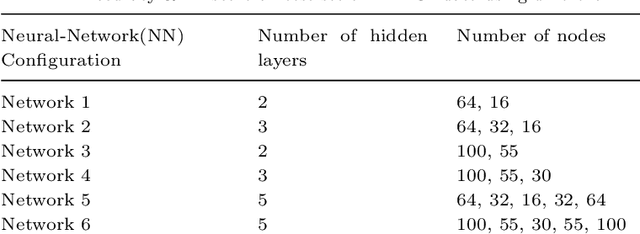
Abstract:Single-cell RNA sequencing (scRNA-seq) enables the study of cellular diversity at single cell level. It provides a global view of cell-type specification during the onset of biological mechanisms such as developmental processes and human organogenesis. Various statistical, machine and deep learning-based methods have been proposed for cell-type classification. Most of the methods utilizes unsupervised lower dimensional projections obtained from for a large reference data. In this work, we proposed a reference-based method for cell type classification, called EnProCell. The EnProCell, first, computes lower dimensional projections that capture both the high variance and class separability through an ensemble of principle component analysis and multiple discriminant analysis. In the second phase, EnProCell trains a deep neural network on the lower dimensional representation of data to classify cell types. The proposed method outperformed the existing state-of-the-art methods when tested on four different data sets produced from different single-cell sequencing technologies. The EnProCell showed higher accuracy (98.91) and F1 score (98.64) than other methods for predicting reference from reference datasets. Similarly, EnProCell also showed better performance than existing methods in predicting cell types for data with unknown cell types (query) from reference datasets (accuracy:99.52; F1 score: 99.07). In addition to improved performance, the proposed methodology is simple and does not require more computational resources and time. the EnProCell is available at https://github.com/umar1196/EnProCell.
Integration of Beyond Diagonal RIS and UAVs in 6G NTNs: Enhancing Aerial Connectivity
Sep 09, 2024



Abstract:The reconfigurable intelligent surface (RIS) technology shows great potential in sixth-generation (6G) terrestrial and non-terrestrial networks (NTNs) since it can effectively change wireless settings to improve connectivity. Extensive research has been conducted on traditional RIS systems with diagonal phase response matrices. The straightforward RIS architecture, while cost-effective, has restricted capabilities in manipulating the wireless channels. The beyond diagonal reconfigurable intelligent surface (BD-RIS) greatly improves control over the wireless environment by utilizing interconnected phase response elements. This work proposes the integration of unmanned aerial vehicle (UAV) communications and BD-RIS in 6G NTNs, which has the potential to further enhance wireless coverage and spectral efficiency. We begin with the preliminaries of UAV communications and then discuss the fundamentals of BD-RIS technology. Subsequently, we discuss the potential of BD-RIS and UAV communications integration. We then proposed a case study based on UAV-mounted transmissive BD-RIS communication. Finally, we highlight future research directions and conclude this work.
Floods Relevancy and Identification of Location from Twitter Posts using NLP Techniques
Jan 01, 2023Abstract:This paper presents our solutions for the MediaEval 2022 task on DisasterMM. The task is composed of two subtasks, namely (i) Relevance Classification of Twitter Posts (RCTP), and (ii) Location Extraction from Twitter Texts (LETT). The RCTP subtask aims at differentiating flood-related and non-relevant social posts while LETT is a Named Entity Recognition (NER) task and aims at the extraction of location information from the text. For RCTP, we proposed four different solutions based on BERT, RoBERTa, Distil BERT, and ALBERT obtaining an F1-score of 0.7934, 0.7970, 0.7613, and 0.7924, respectively. For LETT, we used three models namely BERT, RoBERTa, and Distil BERTA obtaining an F1-score of 0.6256, 0.6744, and 0.6723, respectively.
Energy-Efficient Beamforming and Resource Optimization for AmBSC-Assisted Cooperative NOMA IoT Networks
Sep 11, 2022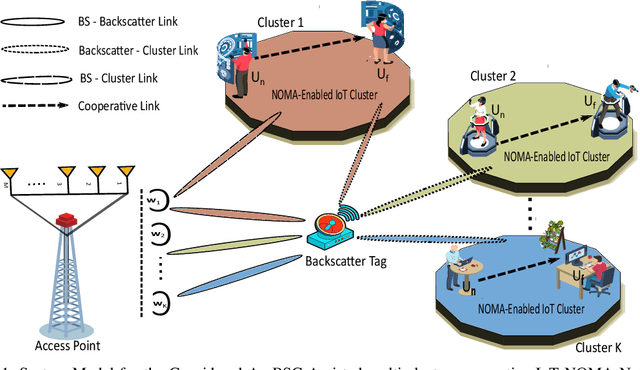
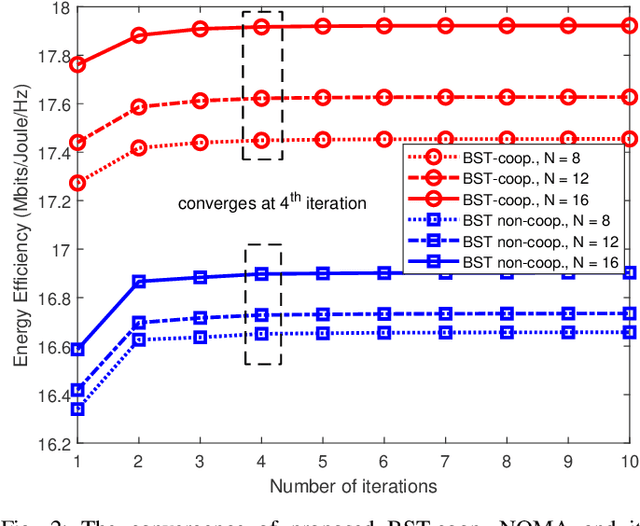
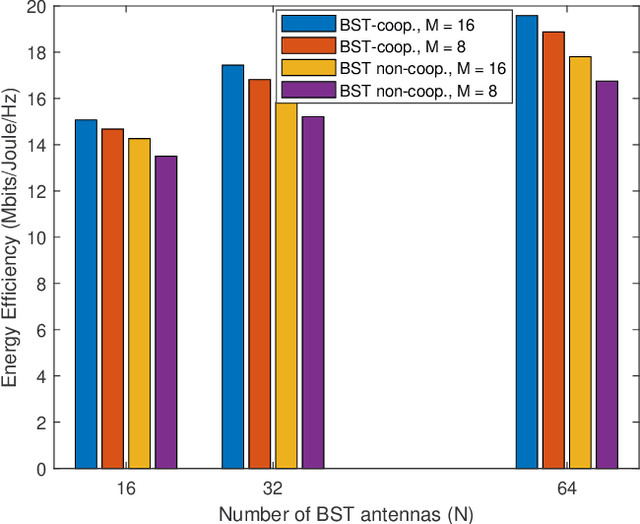
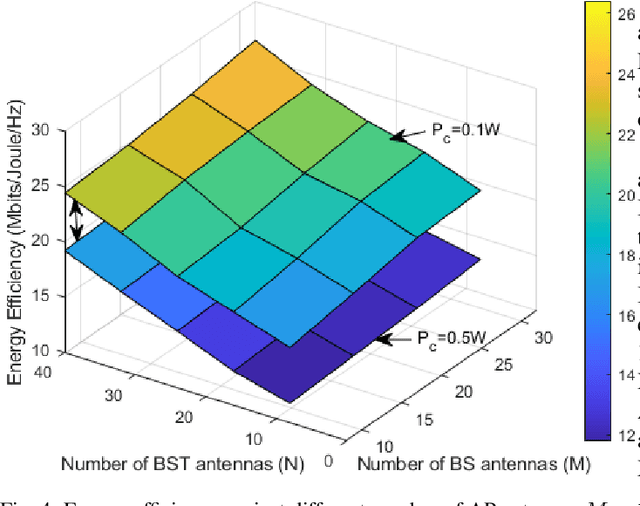
Abstract:In this manuscript, we present an energy-efficient alternating optimization framework based on the multi-antenna ambient backscatter communication (AmBSC) assisted cooperative non-orthogonal multiple access (NOMA) for next-generation (NG) internet-of-things (IoT) enabled communication networks. Specifically, the energy-efficiency maximization is achieved for the considered AmBSC-enabled multi-cluster cooperative IoT NOMA system by optimizing the active-beamforming vector and power-allocation coefficients (PAC) of IoT NOMA users at the transmitter, as well as passive-beamforming vector at the multi-antenna assisted backscatter node. Usually, increasing the number of IoT NOMA users in each cluster results in inter-cluster interference (ICI) (among different clusters) and intra-cluster interference (among IoT NOMA users). To combat the impact of ICI, we exploit a zero-forcing (ZF) based active-beamforming, as well as an efficient clustering technique at the source node. Further, the effect of intra-cluster interference is mitigated by exploiting an efficient power-allocation policy that determines the PAC of IoT NOMA users under the quality-of-service (QoS), cooperation, SIC decoding, and power-budget constraints. Moreover, the considered non-convex passive-beamforming problem is transformed into a standard semi-definite programming (SDP) problem by exploiting the successive-convex approximation (SCA) approximation, as well as the difference of convex (DC) programming, where Rank-1 solution of passive-beamforming is obtained based on the penalty-based method. Furthermore, the numerical analysis of simulation results demonstrates that the proposed energy-efficiency maximization algorithm exhibits an efficient performance by achieving convergence within only a few iterations.
Rate Splitting Multiple Access for Next Generation Cognitive Radio Enabled LEO Satellite Networks
Aug 07, 2022



Abstract:This paper proposes a cognitive radio enabled LEO SatCom using RSMA radio access technique with the coexistence of GEO SatCom network. In particular, this work aims to maximize the sum rate of LEO SatCom by simultaneously optimizing the power budget over different beams, RSMA power allocation for users over each beam, and subcarrier user assignment while restricting the interference temperature to GEO SatCom. The problem of sum rate maximization is formulated as non-convex, where the global optimal solution is challenging to obtain. Thus, an efficient solution can be obtained in three steps: first we employ a successive convex approximation technique to reduce the complexity and make the problem more tractable. Second, for any given resource block user assignment, we adopt KKT conditions to calculate the transmit power over different beams and RSMA power allocation of users over each beam. Third, using the allocated power, we design an efficient algorithm based on the greedy approach for resource block user assignment. Numerical results demonstrate the benefits of the proposed optimization scheme compared to the benchmark schemes.
Energy Efficiency Maximization for Backscatter-Enabled Coded-Cooperative NOMA Under Imperfect SIC
Aug 01, 2022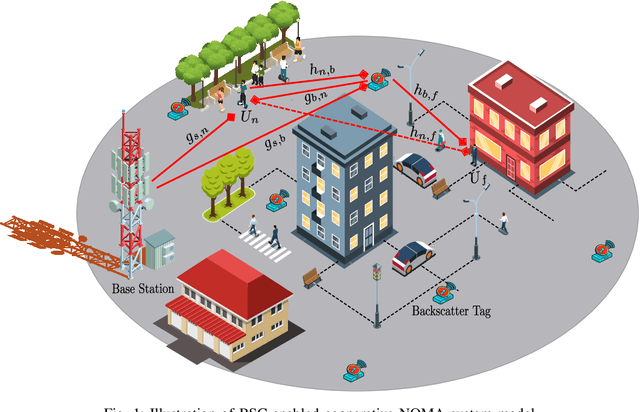
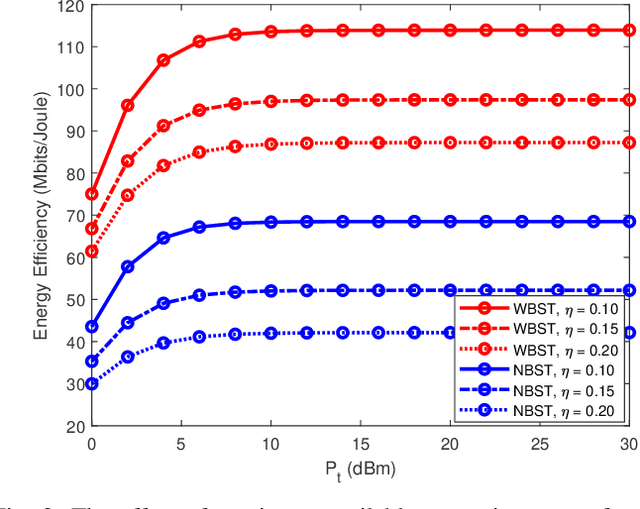
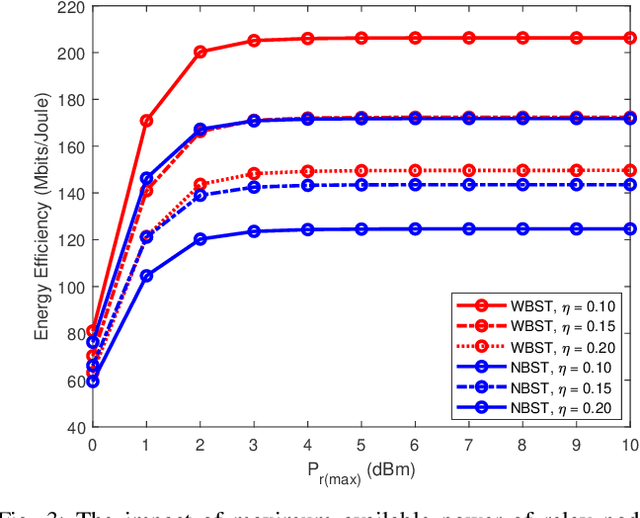
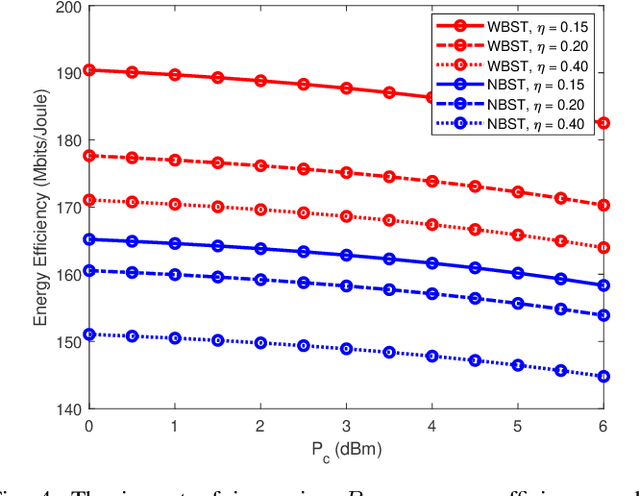
Abstract:In this manuscript, we propose an optimization framework to maximize the energy efficiency of the BSC-enabled cooperative NOMA system under imperfect successive interference cancellation (SIC) decoding at the receiver. Specifically, the energy efficiency of the system is maximized by optimizing the transmit power of the source, power allocation coefficients (PAC) of NOMA users, and power of the relay node. A low-complexity energy-efficient alternating optimization framework is introduced which simultaneously optimizes the transmit power of the source, PAC, and power of the relay node by considering the quality of service (QoS), power budget, and cooperation constraints under the imperfect SIC decoding. Subsequently, a joint channel coding framework is provided to enhance the performance of far user which has no direct communication link with the base station (BS) and has bad channel conditions. In the destination node, the far user data is jointly decoded using a Sum-product algorithm (SPA) based joint iterative decoder realized by jointly-designed Quasi-cyclic Low-density parity-check (QC-LDPC) codes obtained from cyclic balanced sampling plans excluding contiguous units (CBSEC). Simulation results evince that the proposed BSC-enabled cooperative NOMA system outperforms its counterpart by providing an efficient performance in terms of energy efficiency. Also, proposed jointly-designed QC-LDPC codes provide an excellent bit-error-rate (BER) performance by jointly decoding the far user data for considered BSC cooperative NOMA system with only a few decoding iterations under Rayleigh-fading transmission.
Cooperative Backscatter NOMA with Imperfect SIC: Towards Energy Efficient Sum Rate Maximization in Sustainable 6G Networks
Jul 07, 2022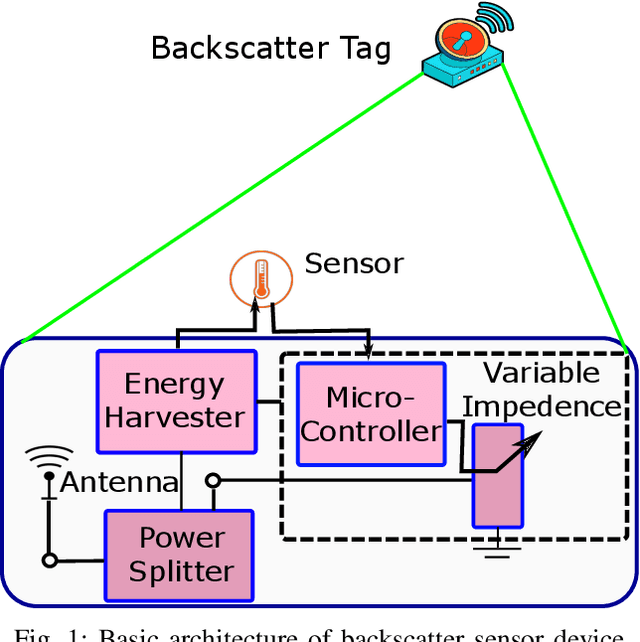
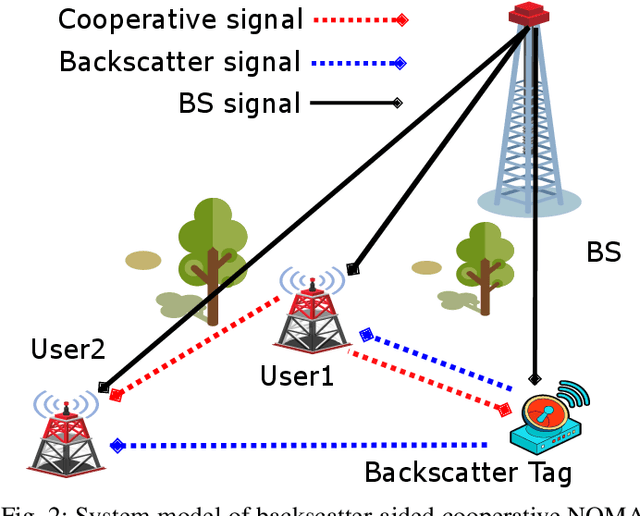
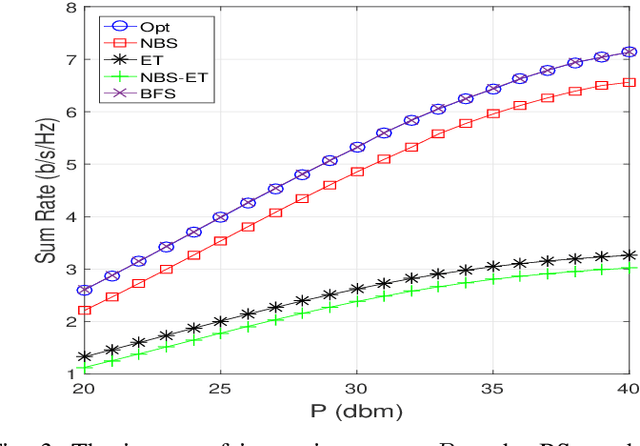
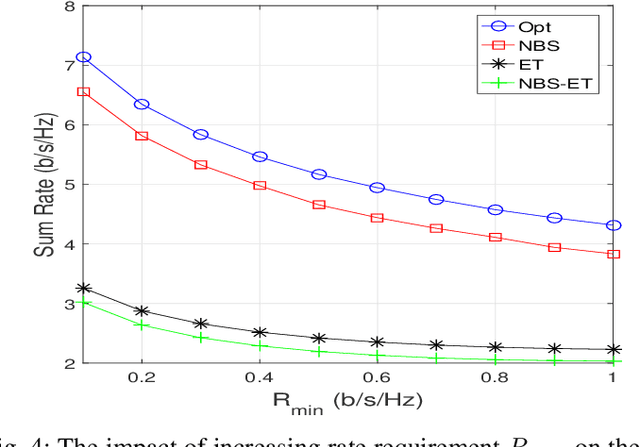
Abstract:The combination of backscatter communication with non-orthogonal multiple access (NOMA) has the potential to support low-powered massive connections in upcoming sixth-generation (6G) wireless networks. More specifically, backscatter communication can harvest and use the existing RF signals in the atmosphere for communication, while NOMA provides communication to multiple wireless devices over the same frequency and time resources. This paper has proposed a new resource management framework for backscatter-aided cooperative NOMA communication in upcoming 6G networks. In particular, the proposed work has simultaneously optimized the base station's transmit power, relaying node, the reflection coefficient of the backscatter tag, and time allocation under imperfect successive interference cancellation to maximize the sum rate of the system. To obtain an efficient solution for the resource management framework, we have proposed a combination of the bisection method and dual theory, where the sub-gradient method is adopted to optimize the Lagrangian multipliers. Numerical results have shown that the proposed solution provides excellent performance. When the performance of the proposed technique is compared to a brute-forcing search technique that guarantees optimal solution however, is very time-consuming, it was seen that the gap in performance is actually 0\%. Hence, the proposed framework has provided performance equal to a cumbersome brute-force search technique while offering much less complexity. The works in the literature on cooperative NOMA considered equal time distribution for cooperation and direct communication. Our results showed that optimizing the time-division can increase the performance by more than 110\% for high transmission powers.
LSTM-Based Distributed Conditional Generative Adversarial Network For Data-Driven 5G-Enabled Maritime UAV Communications
May 09, 2022



Abstract:5G enabled maritime unmanned aerial vehicle (UAV) communication is one of the important applications of 5G wireless network which requires minimum latency and higher reliability to support mission-critical applications. Therefore, lossless reliable communication with a high data rate is the key requirement in modern wireless communication systems. These all factors highly depend upon channel conditions. In this work, a channel model is proposed for air-to-surface link exploiting millimeter wave (mmWave) for 5G enabled maritime unmanned aerial vehicle (UAV) communication. Firstly, we will present the formulated channel estimation method which directly aims to adopt channel state information (CSI) of mmWave from the channel model inculcated by UAV operating within the Long Short Term Memory (LSTM)-Distributed Conditional generative adversarial network (DCGAN) i.e. (LSTM-DCGAN) for each beamforming direction. Secondly, to enhance the applications for the proposed trained channel model for the spatial domain, we have designed an LSTM-DCGAN based UAV network, where each one will learn mmWave CSI for all the distributions. Lastly, we have categorized the most favorable LSTM-DCGAN training method and emanated certain conditions for our UAV network to increase the channel model learning rate. Simulation results have shown that the proposed LSTM-DCGAN based network is vigorous to the error generated through local training. A detailed comparison has been done with the other available state-of-the-art CGAN network architectures i.e. stand-alone CGAN (without CSI sharing), Simple CGAN (with CSI sharing), multi-discriminator CGAN, federated learning CGAN and DCGAN. Simulation results have shown that the proposed LSTM-DCGAN structure demonstrates higher accuracy during the learning process and attained more data rate for downlink transmission as compared to the previous state of artworks.
Energy-Efficient IRS-Aided NOMA Beamforming for 6G Wireless Communications
Mar 30, 2022



Abstract:This manuscript presents an energy-efficient alternating optimization framework based on intelligent reflective surfaces (IRS) aided non-orthogonal multiple access beamforming (NOMA-BF) system for 6G wireless communications. Specifically, this work proposes a centralized IRS-enabled design for the NOMA-BF system to optimize the active beamforming and power allocation coefficient (PAC) of users at the transmitter in the first stage and passive beamforming at IRS in the 2nd stage to maximize the energy efficiency (EE) of the network. However, an increment in the number of supportable users with the NOMA-BF system will lead to NOMA user interference and inter-cluster interference (ICI). To mitigate the effect of ICI, first zero-forcing beamforming along with efficient user clustering algorithm is exploited and then NOMA user interference is tackled efficiently through a proposed iterative algorithm that computes PAC of NOMA user through simplified closed-form expression under the required system constraints. In the 2nd stage, the problem of passive beamforming is solved through a technique based on difference-of-convex (DC) programming and successive convex approximation (SCA). Simulation results demonstrate that the proposed alternating framework for energy-efficient IRS-assisted NOMA-BF system can achieve convergence within a few iterations and provide efficient performance in terms of EE of the system with low complexity.
 Add to Chrome
Add to Chrome Add to Firefox
Add to Firefox Add to Edge
Add to Edge